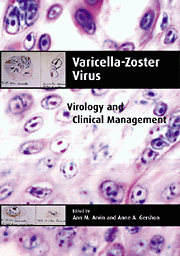Book contents
- Frontmatter
- Contents
- List of contributors
- Preface
- Introduction
- Part I History
- Part II Molecular Biology and Pathogenesis
- 2 Molecular evolution of alphaherpesviruses
- 3 DNA replication
- 4 Viral proteins
- 5 Pathogenesis of primary infection
- 6 Pathogenesis of latency and reactivation
- 7 Host response to primary infection
- 8 Host response during latency and reactivation
- 9 Animal models of infection
- Part III Epidemiology and Clinical Manifestations
- Part IV Laboratory Diagnosis
- Part V Treatment and Prevention
- Index
- Plate section
3 - DNA replication
from Part II - Molecular Biology and Pathogenesis
Published online by Cambridge University Press: 02 March 2010
- Frontmatter
- Contents
- List of contributors
- Preface
- Introduction
- Part I History
- Part II Molecular Biology and Pathogenesis
- 2 Molecular evolution of alphaherpesviruses
- 3 DNA replication
- 4 Viral proteins
- 5 Pathogenesis of primary infection
- 6 Pathogenesis of latency and reactivation
- 7 Host response to primary infection
- 8 Host response during latency and reactivation
- 9 Animal models of infection
- Part III Epidemiology and Clinical Manifestations
- Part IV Laboratory Diagnosis
- Part V Treatment and Prevention
- Index
- Plate section
Summary
Structure and physical properties of VZV DNA
The varicella-zoster virus (VZV) genome is a linear double-stranded DNA molecule consisting of approximately 125000 base pairs with an average G + C content of 46%. Computer analysis of the sequence predicted the presence of approximately 70 open reading frames (ORFs). The genome is similar in overall structure to other alphaherpesvirus DNAs and its significant colinearity with the herpes simplex virus type 1 (HSV-1) sequence facilitated assignment of the ORFs (Davison & Scott, 1986). The VZV genome consists of two covalently linked segments, L and S, which are in turn composed of unique sequences UL and US. These unique regions are bounded by inverted repeat sequences IRL/TRL and IRS/TRS, respectively (Figure 3.1). In the genome of the Dumas strain, which was completely sequenced by Davison & Scott (1986), the UL region consists of 104 836bp flanked by 88.5 bp inverted repeats and the US region consists of 5232bp flanked by 7319.5 bp inverted repeats. These data are consistent with earlier estimates of the size of the genome derived from electron microscopic measurements, restriction enzyme analysis, and the overall G + C content estimated by bouyant density (Ludwig et al., 1972; Dumas et al., 1980, 1981; Straus et al., 1981; Davison & Scott, 1983).
Analysis of restriction enzyme digests of DNA derived from purified virions of numerous strains indicated that unlike the herpes simplex genome, which has a distinctive strain-dependent restriction fragment fingerprint, only a few “geographic” restriction fragment polymorphisms present or absent in VZV DNA genomes isolated in Asia or western Europe and the US were observed.
- Type
- Chapter
- Information
- Varicella-Zoster VirusVirology and Clinical Management, pp. 51 - 73Publisher: Cambridge University PressPrint publication year: 2000
- 9
- Cited by

